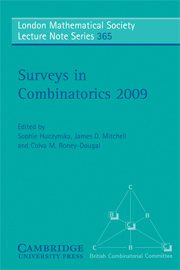Book contents
- Frontmatter
- Contents
- Preface
- 1 Graph decompositions and symmetry
- 2 Combinatorics of optimal designs
- 3 Regularity and the spectra of graphs
- 4 Trades and t-designs
- 5 Extremal graph packing problems: Ore-type versus Dirac-type
- 6 Embedding large subgraphs into dense graphs
- 7 Counting planar graphs and related families of graphs
- 8 Metrics for sparse graphs
- 9 Recent results on chromatic and flow roots of graphs and matroids
8 - Metrics for sparse graphs
Published online by Cambridge University Press: 05 May 2013
- Frontmatter
- Contents
- Preface
- 1 Graph decompositions and symmetry
- 2 Combinatorics of optimal designs
- 3 Regularity and the spectra of graphs
- 4 Trades and t-designs
- 5 Extremal graph packing problems: Ore-type versus Dirac-type
- 6 Embedding large subgraphs into dense graphs
- 7 Counting planar graphs and related families of graphs
- 8 Metrics for sparse graphs
- 9 Recent results on chromatic and flow roots of graphs and matroids
Summary
Abstract
Recently, Bollobás, Janson and Riordan introduced a very general family of random graph models, producing inhomogeneous random graphs with Θ(n) edges. Roughly speaking, there is one model for each kernel, i.e. each symmetric measurable function from [0, 1]2 to the non-negative reals, although the details are much more complicated, to ensure the exact inclusion of many of the recent models for large-scale real-world networks.
A different connection between kernels and random graphs arises in the recent work of Borgs, Chayes, Lovász, Sós, Szegedy and Vesztergombi. They introduced several natural metrics on dense graphs (graphs with n vertices and Θ(n2) edges), showed that these metrics are equivalent, and gave a description of the completion of the space of all graphs with respect to any of these metrics in terms of graphons, which are essentially bounded kernels. One of the most appealing aspects of this work is the message that sequences of inhomogeneous quasi-random graphs are in a sense completely general: any sequence of dense graphs contains such a subsequence. Alternatively, their results show that certain natural models of dense inhomogeneous random graphs (one for each graphon) cover the space of dense graphs: there is one model for each point of the completion, producing graphs that converge to this point.
- Type
- Chapter
- Information
- Surveys in Combinatorics 2009 , pp. 211 - 288Publisher: Cambridge University PressPrint publication year: 2009
- 25
- Cited by



